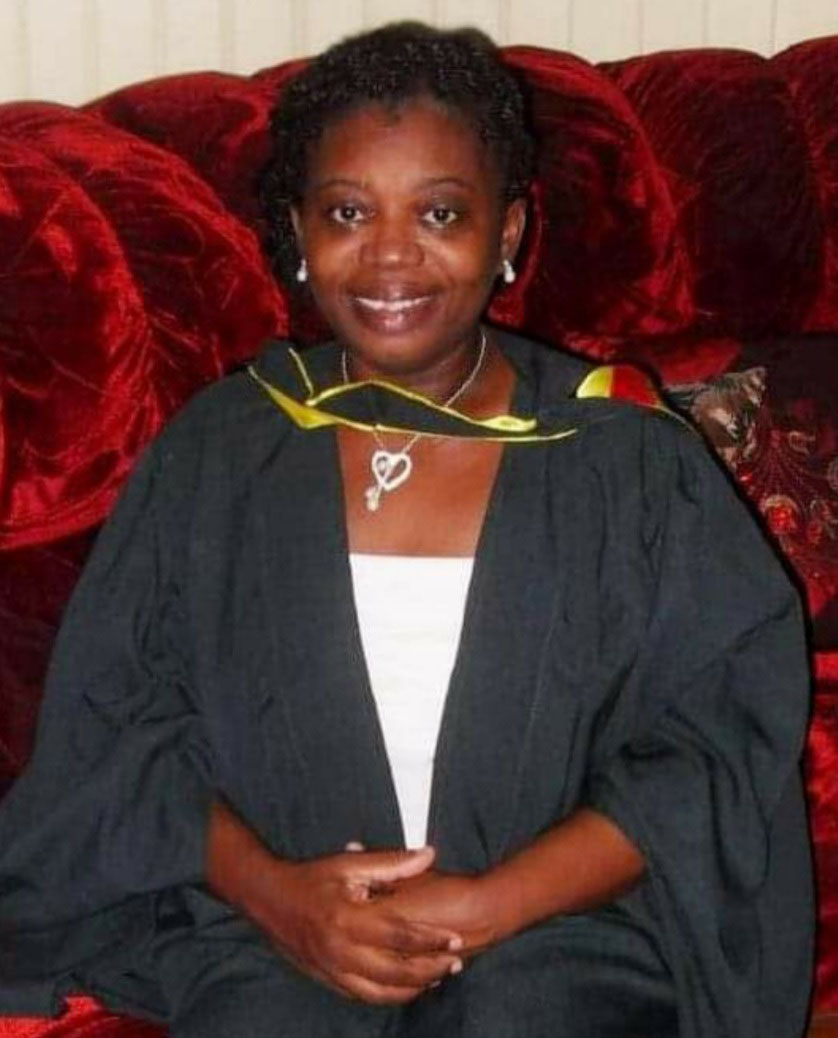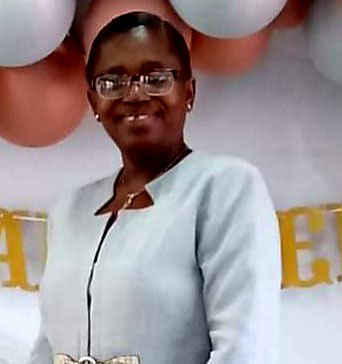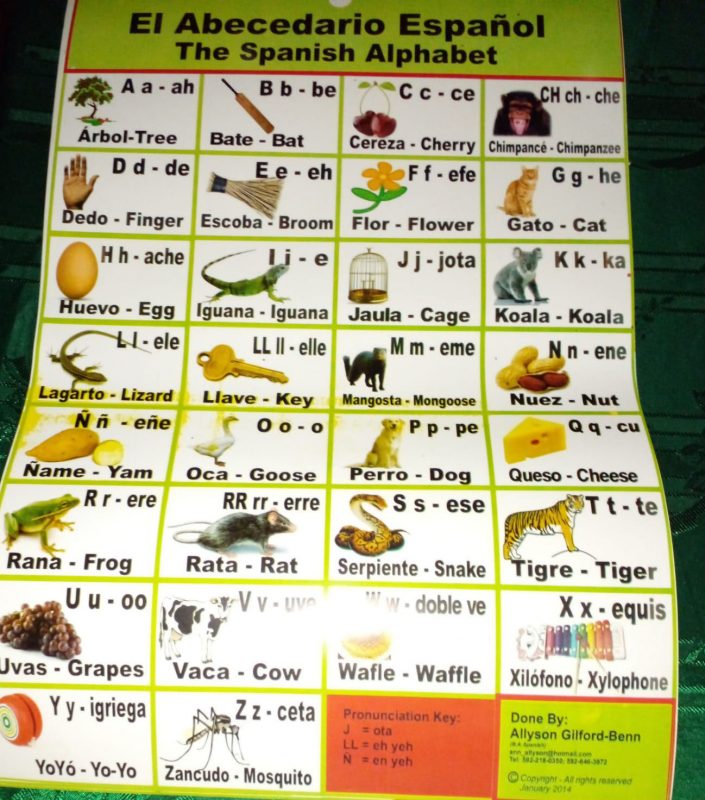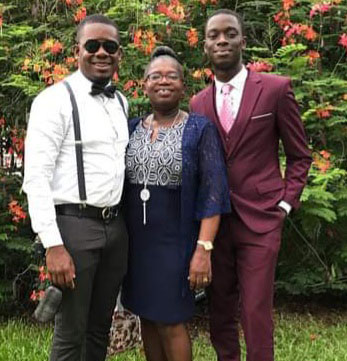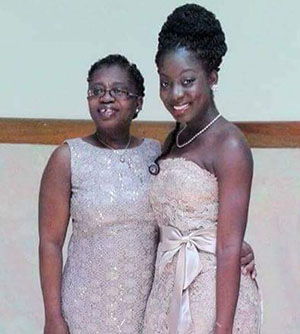Allyson Gilford-Benn has been known to rely on faith. Years ago, she had quit her job as a banker to nurture her young children, rearing chickens and driving a minibus to make ends meet while doing so. Much later, she returned to the classroom after 27 years to pursue a bachelor’s degree in modern languages majoring in Spanish at the University of Guyana (UG).
She has since created a Spanish alphabet that is being used countrywide as a teaching and learning aid. She has produced workbooks for the seven levels of pupils she teaches, but most of all she is proud that her children are now professionals giving back to society.
“I developed the Spanish alphabet because I realised we are not giving our children the necessary foundation. When we teach our children English language in the nurseries, we have an English alphabet for them, ain’t it? If you are going to teach Spanish as a foreign language, you need a Spanish alphabet,” Gilford-Benn told Stabroek Weekend.
“Children from Spanish-speaking Venezuela are in our schools learning English. Within a year they are speaking perfect English without a Spanish accent,” she noted. “If we don’t get our act together in learning a foreign language, Spanish in particular, with the influx of foreigners coming into this country with the oil boom, when the banks or other employers are ready, they will employ the bilingual children coming out of our school system because they will be able to communicate with the customers.
“My cry is for us to ensure our country is prepared for what is to come. Train teachers who are already in the system, who are willing to learn the language and give them a stipend or increase their salary. Prepare workbooks for those teachers. We have to start from somewhere. I am one teacher teaching over 1,500 children.”
After 12 years working as a banker first at the Linden branch of the Guyana National Cooperative Bank in 1992 when she was 18 years, and then at the head office in Georgetown, and another two years with the Guyana Bank for Trade and Industry (GBTI), Benn decided to leave her job in 1996.
When she was leaving GBTI, she recalled, a colleague said, ‘You leaving you good job to live hand to mouth’. However, another Christian colleague replied, ‘Yeah, you will live from hand to mouth but from God’s hand to your mouth.’
Now 59 years old, Gilford-Benn was born in Essequibo, then moved to Ituni where her parents originated before they moved to Georgetown where her father, a teacher, was transferred. In Georgetown, she attended Tucville Primary School. She started her secondary education at the Bishops’ High School but when her father took up a four-year scholarship in the USA, her mother and the rest of the family joined him. She attended Burris Laboratory School (established in 1929 as part of the Teachers College of Ball State University) in Indiana, USA and graduated with a high school diploma.
On their return to Guyana, Gilford-Benn was enrolled at Mackenzie High where she completed her secondary education.
She got married in 1987 and gave birth to three children.
“My children were growing up basically unsupervised at home. My last son Jonathan was two years old, Joshua was five, and Crystal, six. As soon as I returned to work my kids were placed in day care centres,” she said. “I knew the Lord wanted me to look after them properly. There is no sense in making money and you cannot nurture them properly.”
She recalled that one day her daughter went home with a broken lunch kit from nursery school. Her daughter said her father had sent someone to pick her up and the lunch kit fell and broke. Gilford-Benn was upset. “I didn’t expect her father to send somebody to pick her up. She was in second grade when I left the job at the bank.”
Not being able to give the children her full attention was also affecting her mentally.
To work, she left home early and got back home late at night. “What attention could I give to the kids?” At the time she left, the bank was transitioning to the automated banking system. “I was working late at night. Many nights I had to take a taxi to get home because the minibuses had stopped running,” she recalled
After leaving the bank, Gilford-Benn started to rear meat birds which she supplied to Guyana Stores Limited and some shops around the area. They lived in South Ruimveldt Park where she and her husband were renting a place which they subsequently bought. Her husband was a spray painter with no regular work.
“We had to find money each month to pay a rent after I left the bank, then pay the mortgage.”
When she left her salaried employment, her two-year-old son stayed at home with her while the two older ones were at nursery and primary schools. When money was not coming in fast enough to meet the daily and other expenses, she had to find another source of income.
The Benns owned a minibus and so she began to pick up school children and drop them off to school while she took her own children to school and back home. “Of course, I took my baby son along with me,” she added.
When she returned home, she looked after the house and the chicken business. “The neighbours complained about the smell of the pens. Thank God I was able to succeed with the chicken business when it mattered. After a while the kids grew up.”
At home Gilford-Benn spent a lot more time with her children and helped them with their studies. “The house was full of posters. I had the map of Guyana, the skeletal system, everything was pasted up around the house, even on the fridge,” she said.
When her children wrote the then Secondary Schools Entrance Examination, her daughter obtained Brickdam Secondary but Gilford-Benn sent her to Marian Academy instead. “That’s when earnings from the chicken business came in handy.” Her second son got a place at St Stanislaus College and her last son secured the Bishops’ High School.
“They went to Tucville Primary, a school that is not often among the top places at common entrance. I know the work I pushed with them, helped them to get reasonably good marks,” she said.
At their respective high schools, the children all performed well.
At present, her daughter is a nurse working in a London hospital, her older son is a lawyer who is on a Chevening Scholarship in London and her last son is a graduate teacher who has produced two educational books. The books “Science Made Easy” and “Social Studies Made Easy” are being used in schools across the country for the National Grade Six Examinations. The Ministry of Education owns part of the books’ copyright.
“Jonathan dedicated the ‘Science Made Easy’ to me because of the work I did as a mother at home with them where their schoolwork was concerned. As a mother you make that sacrifice and it pays off eventually,” she said.
Going to UG
When her two older children had left school and the last one was nearing completion, Gilford-Benn was admitted to the University of Guyana to pursue a bachelor’s degree in Spanish.
She had always liked the Spanish language and had done it as a subject at Mackenzie High School. “I really wanted to continue to know the language well.”
She was 45 years old when she was admitted to UG and she graduated with credit. Some people questioned her decision to do Spanish instead of something to do with the banking system which she was more familiar with.
A UG she expected to do only Spanish and was a bit taken aback that she had to do a minor in English and some other subjects that were not difficult.
“But when it came to Spanish linguistics, which I had to do for a year, it was tough and the thought came to me to quit. I said to myself, this was not what I came for. To me linguistics was like Mathematics and Science, subjects I never liked at school. I didn’t quit because I had to teach my children by example not to be quitters. Many younger students were in the English department and as an adult, I realised I just couldn’t quit. It would look bad. That same linguistics helped me in the long run to do the Spanish alphabet which [is] now on the market.”
The class started off with many students but by the second year a lot of them had dropped out or switched programmes. “In spite of all the naysayers, I did it. I went into the university in 2007 and graduated in 2011.” She was one of two students, the other being a young person, to complete the programme. She noted that the previous year as well only two students graduated from the Spanish programme.
El Abecedario Espanol
The year Gilford-Benn graduated she started teaching at Mae’s School Annexe in Middleton Street, Campbellville. She was asked to source a Spanish alphabet or El Abecedario Espanol and could not find any locally.
In 2014, she developed a Spanish alphabet that is now sold across the country. “It is now in high demand. Up to yesterday [October 14] I made a delivery of the Spanish Alphabet to Giftland Mall. I was the first person in this country to create a Spanish alphabet locally.”
With the Spanish language now introduced in primary schools, the alphabet is in demand.
While she was at UG, Gilford-Benn realised the need for a Spanish alphabet when she was doing linguistics. “If I had done extremely well in this subject I would have gotten a distinction. Linguistics, the scientific aspect of languages, gave me the time of my life but it has paid off. I don’t know how we have been teaching Spanish in the schools and we have not been teaching the alphabet at the foundation level.”
Gilford-Benn prefers to teach younger children entering the school system and moving with them as they move from one level to another. She believes the secondary system does not have a strong foundation in the language. “When you test the children in Grades Nine and Ten, they don’t know how to pronounce Spanish words properly. By the time my students finish Grade One they could pronounce a Spanish word properly because I ensure they learn the Spanish alphabet. Once they know the rules for those letters, they don’t have a problem after that.”
She was most happy when a UG Spanish lecturer, a Cuban, emailed her telling her that the Spanish Alphabet was a “wonderful tool” needed in Guyana. “If we are going to teach Spanish, we have to have a foundation. We can’t just teach from the top of our heads. As a result of that alphabet I have written seven Spanish workbooks for each level I teach.”
The workbooks all have the International Standard Book Number (ISBN) numbers. ISBN is a numeric commercial book identifier that is intended to be unique. “I try to keep a low profile with them because of photocopying. We have photocopying laws here but they are not enforced.”
When she started teaching at the schools in Grade One, by the time the Grade One children moved up to Grade Two, she had a Grade Two workbook prepared. By the time they came up to Grade Three, she had a Grade Three workbook. “So over the years, I had Grades One, Two, Three, Four and Five workbooks prepared.”
She also prepared workbooks for the children at the lower and upper nursery schools levels that are used mainly at Mae’s Schools’ Annexe and Green Acres Nursery.
“Once those children get the groundwork, man, they master the pronunciation of the alphabet and can pronounce a word even if they do not know its meaning.”
Gilford-Benn currently teaches over 1,500 students in the private education system. She has been teaching for over 10 years. She teaches at Green Acres, Mae Schools’ Annexe, Cherished Lambs Primary, WestField Preparatory and Nehemiah Preparatory schools. “At WestField Prep I teach from Grades Four, Five and Six. The other schools I teach from Grades One to Five and at two other schools from lower to upper nursery. I can teach Spanish at all the levels.”
Gilford-Benn was teaching when the Covid-19 pandemic struck. As a part-time teacher she is not paid unless she works. When the pandemic struck and schools were closed she had no students to teach. “It wasn’t until the schools went online that I was able to get back to some teaching.”
To bring in an income, Gilford-Benn advertised online for students wanting to learn the Spanish language. Today she has some 50 students whom she teaches online. She also teaches Spanish to primary pupils and students writing the Caribbean Examinations Council exams. She has classes on Saturday morning from 11.30 am and on Mondays from 6 pm.
Her business is registered as The Spanish Centre. “I pay my taxes and dues. I made my sacrifices for my children over the years and now I’m back on the road,” she said.
